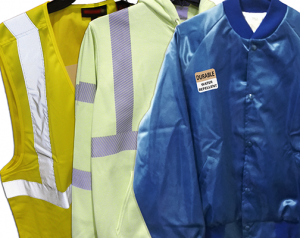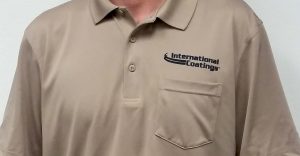Printing Uniforms and Safety Apparel?
March 13, 2019
 What do screen printers need to take note of when working with uniforms and safety apparel?
What do screen printers need to take note of when working with uniforms and safety apparel?
This was a question posed by a Printwear Magazine reader, and here is John Levocz' response:
Workwear today covers a wide variety of garment styles. The polo style shirts worn by workers in many industries are the most common. These garments can be cotton, cotton/poly, or 100 percent polyester.

100% Polyester shirt printed using Performance Pro™ 7100 Series
For the cotton and cotton/poly blend, I recommend using a standard low bleed ink system (such as the Legacy White 7014). If you currently stock inks specifically for cotton and you are sure the garment is 100 percent cotton, a cotton ink system would be fine. The 100 percent polyester garments need to be treated differently. You not only have to use a good low-bleed ink for 100 percent polyester (such as the Performance Pro™ 7100 Series) but you also need to check that the garment can take the temperature required for a proper cure. Some polyester inks are low-cure, but many are not.
Most industrial uniforms that get extremely dirty are sent out to be dry cleaned. Plastisol inks cannot withstand the dry cleaning process and should not be used for these style garments. If a uniform does not get sent out for dry cleaning, it can be printed with a good low-bleed ink system as most uniforms are a blend of cotton and polyester.
Safety apparel is becoming more and more popular to print on. The most popular shirts are the neon green and orange for workers that need to be seen. Most of these garments are a cotton/poly mixture and require the use of a good low-bleed ink system. The 100 percent polyester versions of these garments will need an ink designed for polyester.
If you are being asked to print a reflective ink for EMS, fire, or police be aware that reflective inks will not meet the ANSI government specification for reflectivity like the solid tapes used on safety jackets. Basically, the reflective inks, such as the Optilux® Reflective inks, are made from a base and reflective beads. The beads soak into the garment, leaving them somewhat exposed to reflect light. Follow all the manufacturers’ specifications for printing reflective inks as not all manufacturers’ inks are the same. On nylon safety vests, an ink designed for nylon that will withstand abrasion should be used.
Since these types of garments are made out of a variety of materials I recommend having some of the following on hand for challenging situations:

- Stretch additive
- Low-cure additive
- Low-bleed reducer
- Catalyst or adhesion promoter


